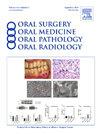地高辛通过 RORγt 依赖性 Th17 反应减轻雄性大鼠与双膦酸盐相关的颌骨坏死症
IF 2
3区 医学
Q2 DENTISTRY, ORAL SURGERY & MEDICINE
Oral Surgery Oral Medicine Oral Pathology Oral Radiology
Pub Date : 2024-08-31
DOI:10.1016/j.oooo.2024.08.013
引用次数: 0
摘要
该研究旨在评估地高辛(一种RORγt抑制剂)对唑来膦酸(ZA)治疗雄性大鼠药物相关性颌骨坏死(MRONJ)的影响。40 只雄性 Wistar 大鼠被分为阴性对照组(0.1 毫升/千克生理盐水)、阳性对照组(ZA,0.20 毫克/千克)和三个试验组,试验组分别使用 1(DG1)、2(DG2)或 4(DG4)毫克/千克的ZA和地高辛进行治疗。这些试验组每周接受三次治疗。第0、7和14天静脉注射ZA,第42天拔除左下第一臼齿,第49天注射最后一次ZA,第70天安乐死。分析包括下颌骨的放射学、组织形态学和免疫组化评估、牙龈的印迹分析以及股骨的机械测试。统计分析采用方差分析/邦费罗尼检验(< .05)。地高辛减少了MRONJ的放射性透明(< .001)、炎症细胞、空骨细胞裂隙(< .001)、凋亡的破骨细胞(< .001)和Caspase-3阳性的骨细胞(= .021)。ZA增加了除c-Fos以外的大多数标记物的免疫活性,而地高辛则降低了白细胞介素17、TNF-α、IL-6、IL-2、FOXP3、c-Jun、NFκB(< .001)、TGF-β(= .009)、RANKL(= .035)和OPG(= .034)。地高辛还逆转了RORγt的表达(< .001),提高了腹泻评分(= .028)、肾脏和心脏指数(< .001),并增强了股骨的机械性能(< .013)。地高辛通过抑制RORγt和减少Th17反应减轻了MRONJ。本文章由计算机程序翻译,如有差异,请以英文原文为准。
Digoxin attenuates bisphosphonate related osteonecrosis of the jaws by RORγt-dependent Th17 response in male rats
Objective
The study aimed to evaluate digoxin, an RORγt inhibitor, in Medication-Related Osteonecrosis of the Jaws (MRONJ) in male rats treated with zoledronic acid (ZA).
Study Design
Forty male Wistar rats were divided into a negative control group (0.1 mL/kg saline), a positive control group (ZA, 0.20 mg/kg), and three test groups treated with ZA and digoxin at 1 (DG1), 2 (DG2), or 4 (DG4) mg/kg. These groups received treatment three times weekly. ZA was administered intravenously on days 0, 7, and 14, followed by extraction of the left lower first molar on day 42, a final ZA dose on day 49, and euthanasia on day 70. Analyses included radiographic, histomorphometric, and immunohistochemical evaluation of the mandibles, western blotting of gingiva, and mechanical tests on femurs. Statistical analysis was performed using ANOVA/Bonferroni tests (P < .05).
Results
Digoxin reduced radiolucency of MRONJ (P < .001), inflammatory cells, empty osteocyte lacunae (P < .001), apoptotic osteoclasts (P < .001), and Caspase-3-positive osteocytes (P = .021). ZA increased immunoreactivity for most markers except c-Fos, while digoxin reduced interleukin 17, TNF-α, IL-6, IL-2, FOXP3, c-Jun, NFκB (P < .001), TGF-β (P = .009), RANKL (P = .035), and OPG (P = .034). Digoxin also reversed RORγt expression (P < .001), increased diarrhea scores (P = .028), renal and cardiac indexes (P < .001), and enhanced femur mechanical properties (P < .013).
Conclusions
Digoxin attenuated MRONJ by inhibiting RORγt and reducing the Th17 response.
求助全文
通过发布文献求助,成功后即可免费获取论文全文。
去求助
来源期刊

Oral Surgery Oral Medicine Oral Pathology Oral Radiology
DENTISTRY, ORAL SURGERY & MEDICINE-
CiteScore
3.80
自引率
6.90%
发文量
1217
审稿时长
2-4 weeks
期刊介绍:
Oral Surgery, Oral Medicine, Oral Pathology and Oral Radiology is required reading for anyone in the fields of oral surgery, oral medicine, oral pathology, oral radiology or advanced general practice dentistry. It is the only major dental journal that provides a practical and complete overview of the medical and surgical techniques of dental practice in four areas. Topics covered include such current issues as dental implants, treatment of HIV-infected patients, and evaluation and treatment of TMJ disorders. The official publication for nine societies, the Journal is recommended for initial purchase in the Brandon Hill study, Selected List of Books and Journals for the Small Medical Library.
 求助内容:
求助内容: 应助结果提醒方式:
应助结果提醒方式:


